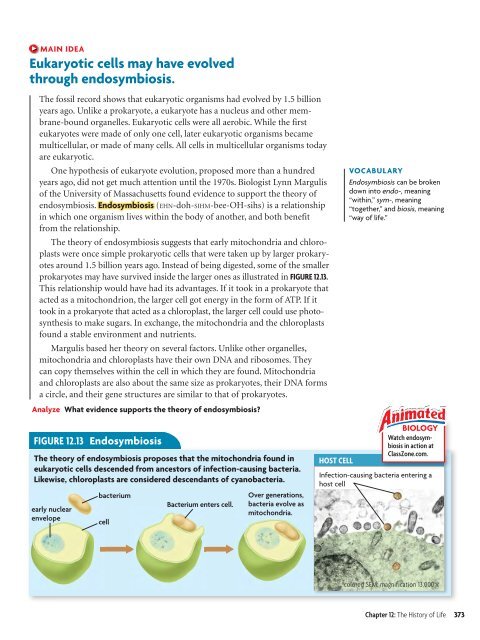12 The History of Life
12 The History of Life
12 The History of Life
- No tags were found...
Create successful ePaper yourself
Turn your PDF publications into a flip-book with our unique Google optimized e-Paper software.
MAIN IDEAEukaryotic cells may have evolvedthrough endosymbiosis.<strong>The</strong> fossil record shows that eukaryotic organisms had evolved by 1.5 billionyears ago. Unlike a prokaryote, a eukaryote has a nucleus and other membrane-boundorganelles. Eukaryotic cells were all aerobic. While the firsteukaryotes were made <strong>of</strong> only one cell, later eukaryotic organisms becamemulticellular, or made <strong>of</strong> many cells. All cells in multicellular organisms todayare eukaryotic.One hypothesis <strong>of</strong> eukaryote evolution, proposed more than a hundredyears ago, did not get much attention until the 1970s. Biologist Lynn Margulis<strong>of</strong> the University <strong>of</strong> Massachusetts found evidence to support the theory <strong>of</strong>endosymbiosis. Endosymbiosis (EHN-doh-SIHM-bee-OH-sihs) is a relationshipin which one organism lives within the body <strong>of</strong> another, and both benefitfrom the relationship.<strong>The</strong> theory <strong>of</strong> endosymbiosis suggests that early mitochondria and chloroplastswere once simple prokaryotic cells that were taken up by larger prokaryotesaround 1.5 billion years ago. Instead <strong>of</strong> being digested, some <strong>of</strong> the smallerprokaryotes may have survived inside the larger ones as illustrated in FIGURE <strong>12</strong>.13.This relationship would have had its advantages. If it took in a prokaryote thatacted as a mitochondrion, the larger cell got energy in the form <strong>of</strong> ATP. If ittook in a prokaryote that acted as a chloroplast, the larger cell could use photosynthesisto make sugars. In exchange, the mitochondria and the chloroplastsfound a stable environment and nutrients.Margulis based her theory on several factors. Unlike other organelles,mitochondria and chloroplasts have their own DNA and ribosomes. <strong>The</strong>ycan copy themselves within the cell in which they are found. Mitochondriaand chloroplasts are also about the same size as prokaryotes, their DNA formsa circle, and their gene structures are similar to that <strong>of</strong> prokaryotes.Analyze What evidence supports the theory <strong>of</strong> endosymbiosis?VOCABULARYEndosymbiosis can be brokendown into endo-, meaning“within,” sym-, meaning“together,” and biosis, meaning“way <strong>of</strong> life.”FIGURE <strong>12</strong>.13 Endosymbiosis<strong>The</strong> theory <strong>of</strong> endosymbiosis proposes that the mitochondria found ineukaryotic cells descended from ancestors <strong>of</strong> infection-causing bacteria.Likewise, chloroplasts are considered descendants <strong>of</strong> cyanobacteria.early nuclearenvelopebacteriumcellBacterium enters cell.Over generations,bacteria evolve asmitochondria.HOST CELLBIOLOGYWatch endosymbiosisin action atClassZone.com.Infection-causing bacteria entering ahost cellcolored SEM; magnification 13,000Chapter <strong>12</strong>: <strong>The</strong> <strong>History</strong> <strong>of</strong> <strong>Life</strong> 373

















